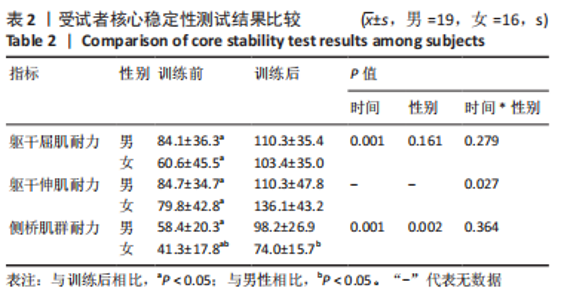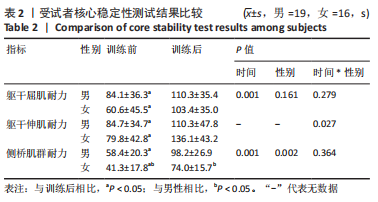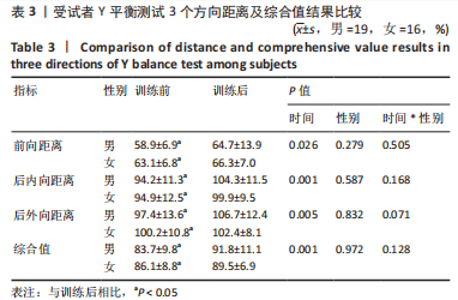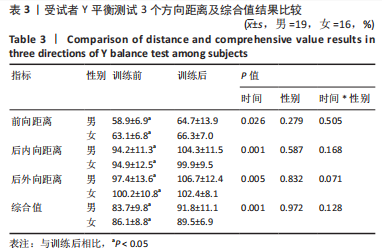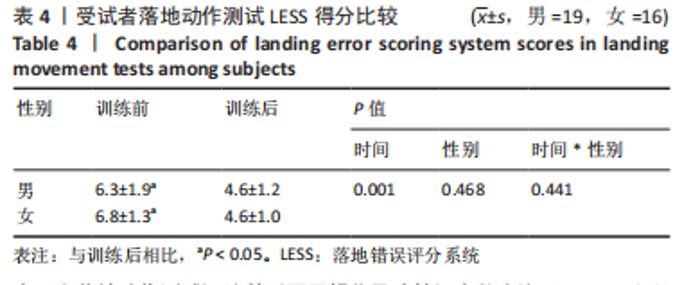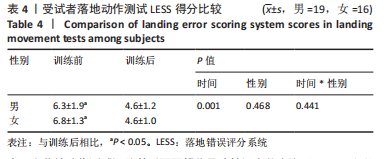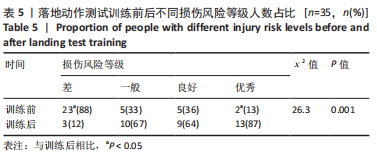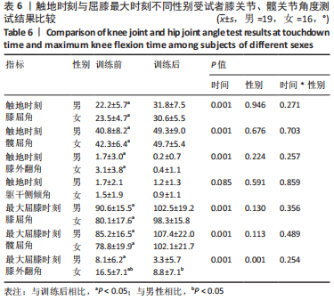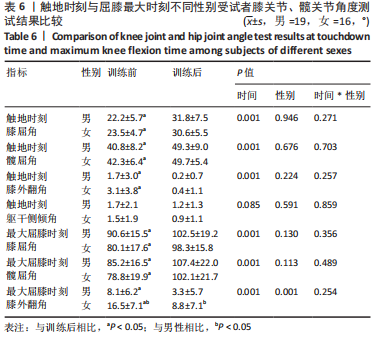[1] RICHARDSON MC, WILKINSON A, CHESTERTON P, et al. Effect of Sand on Landing Knee Valgus During Single-Leg Land and Drop Jump Tasks: Possible Implications for ACL Injury Prevention and Rehabilitation. J Sport Rehabil. 2020;30(1):97-104.
[2] 陈连旭, 付立功.前交叉韧带断裂和重建的临床流行病学分析[J].中国组织工程研究,2016,20(24):3602-3608.
[3] RODRIGUEZ K, SONI M, JOSHI PK, et al. Anterior Cruciate Ligament Injury: Conservative Versus Surgical Treatment. Cureus. 2021;13(12):e20206.
[4] HARATO K, MORISHIGE Y, KOBAYASHI S, et al. Biomechanical features of drop vertical jump are different among various sporting activities. BMC Musculoskelet Disord. 2022; 23(1):331-337.
[5] HEWETT TE, MYER GD, FORD KR, et al. Mechanisms, prediction, and prevention of ACL injuries: Cut risk with three sharpened and validated tools. J Orthop Res. 2016;34(11): 1843-1855.
[6] MARMURA H, BRYANT DM, GETGOOD AM. Infographic. Sex differences and ACL injuries.Br J Sports Med. 2021;55(22):1313-1314.
[7] NOVAES M, CARVALHO A, SAUER JF, et al. Postural control during single leg stance in individuals with clinical indication for combined reconstruction of the anterior cruciate and the anterolateral ligaments of the knee: a cross-sectional study. BMC Musculoskelet Disord. 2022;23(1):383-393.
[8] WELLSANDT E, GARDINIER ES, MANAL K, et al. Decreased Knee Joint Loading Associated With Early Knee Osteoarthritis After Anterior Cruciate Ligament Injury. Am J Sports Med. 2016;44(1):143-151.
[9] PLETCHER ER, DEKKER TJ, LEPHART SM, et al. Sex and Age Comparisons in Neuromuscular And Biomechanical Characteristics of the Knee in Young Athletes. Int J Sports Phys Ther. 2021;16(2):438-449.
[10] KIBLER WB, PRESS J, SCIASCIA A. The role of core stability in athletic function. Sports Med. 2006;36(3):189-198.
[11] PAPPAS E, SHIYKO MP, FORD KR, et al. Biomechanical Deficit Profiles Associated with ACL Injury Risk in Female Athletes. Med Sci Sports Exerc. 2016;48(1):107-113.
[12] JEONG J, CHOI DH, SHIN CS. Core Strength Training Can Alter Neuromuscular and Biomechanical Risk Factors for Anterior Cruciate Ligament Injury. Am J Sports Med. 2021;49(1):183-192.
[13] DUCHENE Y, GAUCHARD GC, MORNIEUX G. Influence of sidestepping expertise and core stability on knee joint loading during change of direction. J Sports Sci. 2022;40(9):959-967.
[14] OTSUKI R, DEL BEL MJ, BENOIT DL. Sex differences in muscle activation patterns associated with anterior cruciate ligament injury during landing and cutting tasks: A systematic review. J Electromyogr Kinesiol. 2021;60:102583.
[15] HEWETT TE, FORD KR, XU YY, et al. Utilization of ACL Injury Biomechanical and Neuromuscular Risk Profile Analysis to Determine the Effectiveness of Neuromuscular Training. Am J Sports Med. 2016;44(12):3146-3151.
[16] HEWETT TE, FORD KR, XU YY, et al. Effectiveness of Neuromuscular Training Based on the Neuromuscular Risk Profile. Am J Sports Med. 2017;45(9):2142-2147.
[17] SINSURIN K, VACHALATHITI R, JALAYONDEJA W, et al. Altered Peak Knee Valgus during Jump-Landing among Various Directions in Basketball and Volleyball Athletes. Asian J Sports Med. 2013;4(3):195-200.
[18] KIM H, SON S, SEELEY MK, et al .Functional Fatigue Alters Lower-extremity Neuromechanics during a Forward-side Jump. Int J Sports Med. 2015;36(14):1192-1200.
[19] CANNON J, CAMBRIDGE EDJ, MCGILL SM. Increased core stability is associated with reduced knee valgus during single-leg landing tasks: Investigating lumbar spine and hip joint rotational stiffness. J Biomech. 2021;116:110240-110240.
[20] ZAZULAK BT, HEWETT TE, REEVES NP, et al. Deficits in neuromuscular control of the trunk predict knee injury risk: a prospective biomechanical-epidemiologic study. Am J Sports Med. 2007;35(7):1123-1130.
[21] SASAKI S, TSUDA E, YAMAMOTO Y, et al. Core-Muscle Training and Neuromuscular Control of the Lower Limb and Trunk. J Athl Train. 2019;54(9):959-969.
[22] LIMROONGREUNGRAT W, MAWHINNEY C, KONGTHONGSUNG S, et al. Landing Error Scoring System: Data from Youth Volleyball Players. Data Brief. 2022;41:107916.
[23] HANZL KOV I, H BERT-LOSIER K. Clinical Implications of Landing Distance on Landing Error Scoring System Scores. J Athl Train. 2021;56(6):572-577.
[24] PADUA DA, MARSHALL SW, BOLING MC, et al. The Landing Error Scoring System (LESS) Is a valid and reliable clinical assessment tool of jump-landing biomechanics: The JUMP-ACL study. Am J Sports Med. 2009;37(10):1996-2002.
[25] MCGILL SM, CHILDS A, LIEBENSON C. Endurance times for low back stabilization exercises: clinical targets for testing and training from a normal database. Arch Phys Med Rehabil. 1999;80(8):941-944.
[26] 杰弗里·M. 威拉德逊. 王轩译. 美国国家体能协会核心训练指南(修订版)[M].北京:人民邮电出版社,2019:42-50.
[27] VERSTEGEN M, WILLIAMS P. Core performance:the revolutionary workout program to transform your body and your life. New York:Rodale Press. 2004:62-135.
[28] 林昌瑞. 核心稳定性训练对姿势控制及落地动作前交叉韧带损伤风险的影响[D].济南:山东体育学院,2020.
[29] COHEN J. A power primer. Psychol Bull. 1992;112(1):155-159.
[30] STONE MH, HORNSBY WG, SUAREZ DG, et al. Training Specificity for Athletes: Emphasis on Strength-Power Training: A Narrative Review. J Funct Morphol Kinesiol. 2022;7(4):102-121.
[31] MAO M, YIN Y, LUO D, et al. Evaluation of dynamic postural control during single-leg landing tasks using initial impact force, landing leg stiffness and time to stabilisation.Sports Biomech. 2021:1-14. doi: 10.1080/14763141.2020.1833969.
[32] KAWAGUCHI K, TAKETOMI S, MIZUTANI Y, et al. Dynamic Postural Stability Is Decreased During the Single-Leg Drop Landing Task in Male Collegiate Soccer Players With Chronic Ankle Instability. Orthop J Sports Med. 2022;10(7):23259671221107343.
[33] COUGHLAN GF, FULLAM K, DELAHUNT E, et al. A comparison between performance on selected directions of the star excursion balance test and the Y balance test. J Athl Train. 2012;47(4):366-371.
[34] PLISKY P, SCHWARTKOPF-PHIFER K, HUEBNER B, et al. Systematic Review and Meta-Analysis of the Y-Balance Test Lower Quarter: Reliability, Discriminant Validity, and Predictive Validity. Int J Sports Phys Ther. 2021;16(5):1190-1209.
[35] LEE DK, KIM GM, HA SM, et al. Correlation of the Y-Balance Test with Lower-limb Strength of Adult Women. J Phys Ther Sci. 2014;26(5):641-643.
[36] PLISKY PJ, RAUH MJ, KAMINSKI TW, et al. Star Excursion Balance Test as a predictor of lower extremity injury in high school basketball players. J Orthop Sports Phys Ther. 2006;36(12):911-919.
[37] 薛博士, 王凌志, 程羽翔, 等. 核心稳定性训练对冲击性落地动作下肢损伤风险的影响[C]//第十二届全国体育科学大会论文摘要汇编——墙报交流(体能训练分会). 2022:177-178.
[38] 张帆, 王长生, 袁艳, 等.不同屈膝角度与g值全身振动刺激对下肢肌肉影响的研究[J].北京体育大学学报,2014,37(11):86-91+99.
[39] CHIJIMATSU M, ISHIDA T, YAMANAKA M, et al. Landing instructions focused on pelvic and trunk lateral tilt decrease the knee abduction moment during a single-leg drop vertical jump. Phys Ther Sport. 2020;46:226-233.
[40] SONG Y, LI L, HUGHES G, et al. Trunk motion and anterior cruciate ligament injuries: a narrative review of injury videos and controlled jump-landing and cutting tasks. Sports Biomech. 2023;22(1):46-64.
|
